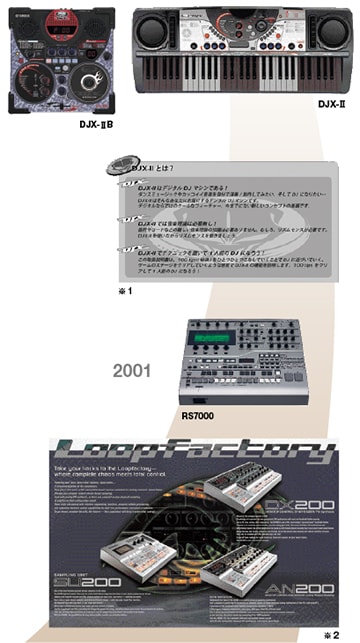Sampling Units & Groove Gear
Sampling Units & Groove Gear

Generally speaking, synth players express themselves musically using the keyboard. There is, however, another class of product that has been optimized specifically for dance music and thus is not equipped with a keyboard. Instead, these products—namely, sampling units and groove gear—are played by means of pads, buttons, and dials, as well as a ribbon controller for scratching and other similar techniques.
In 1995, Yamaha released the SU10—a sampling unit that was capable of sampling sounds at CD-level high quality, and as with the QY Series, had a compact design no larger than a VHS video cassette. In addition to sampling and playback, this instrument also supported DJ techniques such as scratching and crossfading thanks to a built-in ribbon controller. The CS1x Control Synthesizer released the following year had a similar color scheme, so from both design and functional perspectives, there was a strong sense that these two instruments were well suited for use together.
Introduced in 1998, the SU700 featured a sampler, a sequencer, an effects unit, and a mixer, each of which had professional-grade specifications. It was marketed as a “sampling remixer”—a new type of instrument capable of revolutionizing music production through the creation of intense, edgy sampling phrases. The SU700 came with a built-in 3.5-inch floppy-disk drive for data storage as standard, and SCSI support was available as an optional extra. As such, it could hold its own with the rack-mounted A Series samplers that were introduced around the same time.
Also released at the end of the nineties, the RM1x groovebox featured a tone generator optimized for the dance music scene together with serious sequencing power in place of sampling. Its advanced functionality could be used to create remixes; meanwhile, sequence data could also be controlled in real time. This made it possible to create inspired, high-octane phrase sequences—one of the most popular features of this highly original instrument.
As the successor to the SU10, the SU200 that we introduced in 2000 could automatically synchronize up to six loop samples having different tempos. This loop machine also allowed its player to control playback tempo and a wide variety of other parameters on the fly, and despite its compact design, the SU200 supported synchronized playback with the RM1x, among a host of other real-time operations.

*1 From the DJX-II user's manual
*2 The international edition of the Loopfactory catalog (2000)
The SU200 was promoted as a Loopfactory, together with the AN200 and DX200 desktop synthesizers.
Based on a concept unlike anything seen before, the DJX-II and the DJX-IIB arrived on the scene at the same time. Although equipped with an impressive array of powerful DJ functions, these instruments also shared many components and features with older synths, such as sampling and highly versatile effects. Yet their owner’s manuals were most intriguing—for example, one section provides 100 tips on how to DJ. And while the DJX-II came with a built-in keyboard, it is interesting to note that the catalogs and other promotional material of the time boldly stated that this instrument was not intended to be played in the usual fashion, but to be used instead as an interface for controlling sounds.
Introduced in 2001 at the same time as our MOTIF synth, the RS7000 is a music production workstation that integrates an RM1x and a SU700 into one device, providing functions and effects that were the state-of-the-art at the time. This instrument also featured an Integrated Sampling Sequencer (ISS), which combines samples with MIDI, something that was highly significant in the way in which it changed the conventional approach to music production. The ISS and many other unique features of the RS7000 later found their way into the MOTIF as these instruments disappeared from our product lineup. Hand in hand with the synthesizer, however, they played a crucial role in setting up the music scene of the 21st century, where loop- and block-based music production techniques have become the mainstay.





